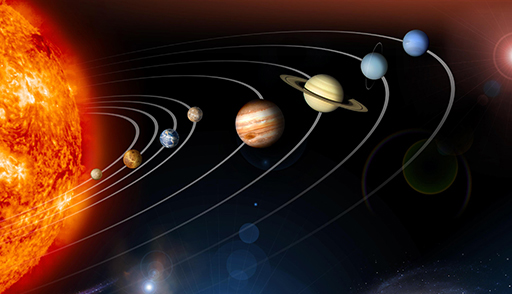1.2 Two characteristics of planets
The observations of phases, as covered in Section 1.1 and explained in Figure 7 below, indicate two characteristics of planets: they orbit the Sun and they don’t produce light of their own. The light we see from planets is reflected light from the Sun. Because of this, planets are much dimmer than the Sun, and so we can see them easily only at night.

Another effect that Figures 6 and 7 show is the change in apparent size of Venus, due to the changing distance between the Earth and Venus during their orbits. Exactly the same effects happen with Mercury: it shows phases and changes in apparent size. The reasons are also the same: Mercury reflects the Sun’s light, and Mercury orbits the Sun.
Some planets orbit closer to the Sun than the Earth does, and some orbit at greater distances. For a transit to occur, the planet in question has to be on an orbit that is inside the Earth’s orbit. In the Solar System we can only ever see transits of Venus and Mercury because the other planets never pass directly between the Earth and the Sun.
Collectively, the Sun, its planets, together with other smaller objects, are known as the Solar System (Figure 8).
Activity 1 Distance from the Sun
Using the internet to find information, arrange the following ten objects in order of their distance from the Sun (Hint: My Very Easy Method Just Speeds Up Naming Planets):
(1 = nearest, 10 = furthest)
Two lists follow, match one item from the first with one item from the second. Each item can only be matched once. There are 10 items in each list.
Mercury
Venus
Earth
Mars
asteroid belt
Jupiter
Saturn
Uranus
Neptune
Pluto
Match each of the previous list items with an item from the following list:
a.7
b.5
c.2
d.6
e.9
f.3
g.1
h.8
i.10
j.4
- 1 = g,
- 2 = c,
- 3 = f,
- 4 = j,
- 5 = b,
- 6 = d,
- 7 = a,
- 8 = h,
- 9 = e,
- 10 = i
In Activity 1 you arranged objects in our Solar System in order of their distance from the Sun. While considering the information needed to complete this activity, you might have noticed that our nearest neighbour planets, Venus and Mars, are quite similar to the Earth in size and mass. In contrast, the outer Solar System contains some much bigger and more massive planets. You will learn more about the different types of planet in Week 2.
Before 1995, astronomers assumed that if other planetary systems existed outside our Solar System, they were probably similar to our own. As you learn about exoplanets, it will become clear that this is not always true. It is useful, however, to be able to compare exoplanets with the more familiar planets of our own Solar System. If you used the internet to find or check the information needed for Activity 1, you probably found some beautiful images of the Solar System. You are encouraged to seek out images like this: astronomy explores a spectacular Universe!

